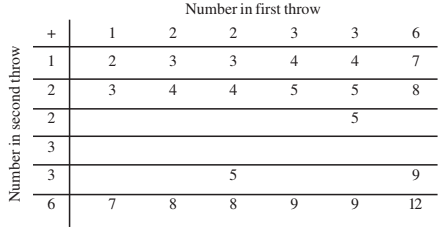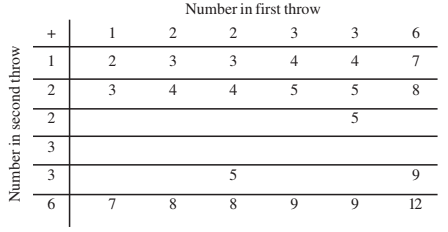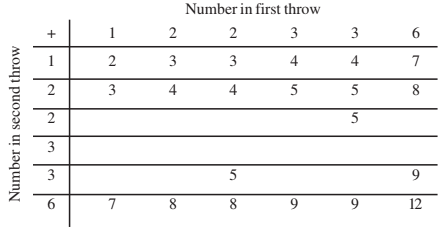Probability Class 10 Chapter 15 Exercise: 15.2
Answer:
Total possible ways Shyam and Ekta can visit the shop = $5\times5 = 25$
(1) A case that both will visit the same day.
Shyam can go on any day between Tuesday to Saturday in 5 ways.
For any day that Shyam goes, Ekta will go on the same day in 1 way.
Total ways that they both go in the same day = $5\times1 = 5$
$\therefore P(both\ go\ on\ same\ day) = \frac{5}{25} = \frac{1}{5}$
Answer:
Total possible ways Shyam and Ekta can visit the shop = $5\times5 = 25$
(2) The case that both will visit the shop on consecutive days.
Shyam can go on any day between Tuesday to Friday in 4 ways.
For any day that Shyam goes, Ekta will go on the next day in 1 way
Similarly, Ekta can go on any day between Tuesday to Friday in 4 ways.
And Shyam will go on the next day in 1 way.
(Note: None of the cases repeats since they are in a different order!)
Total ways that they both go in the same day = $4\times1+4\times1 =8$
$\therefore P(they\ go\ on\ consecutive\ days) = \frac{8}{25}$
Answer:
Total possible ways Shyam and Ekta can visit the shop = $5\times5 = 25$
(1) A case that both will visit the same day.
Shyam can go on any day between Tuesday to Saturday in 5 ways.
For any day that Shyam goes, Ekta will go on a different day in $(5-1) = 4$ ways.
Total ways that they both go in the same day = $5\times4 = 20$
$\therefore P(both\ go\ on\ different\ days) = \frac{20}{25} = \frac{4}{5}$

What is the probability that the total score is (i) even?
Answer:
| + | 1 | 2 | 2 | 3 | 3 | 6 |
| 1 | 2 | 3 | 3 | 4 | 4 | 7 |
| 2 | 3 | 4 | 4 | 5 | 5 | 8 |
| 2 | 3 | 4 | 4 | 5 | 5 | 8 |
| 3 | 4 | 5 | 5 | 6 | 6 | 9 |
| 3 | 4 | 5 | 5 | 6 | 6 | 9 |
| 6 | 7 | 8 | 8 | 9 | 9 | 12 |
Total possible outcomes when two dice are thrown = $6\times6=36$
(1) Number of times when the sum is even = 18
$\therefore P(sum\ is\ even) = \frac{18}{36} = \frac{1}{2}$

What is the probability that the total score is (ii) 6?
Answer:
| + | 1 | 2 | 2 | 3 | 3 | 6 |
| 1 | 2 | 3 | 3 | 4 | 4 | 7 |
| 2 | 3 | 4 | 4 | 5 | 5 | 8 |
| 2 | 3 | 4 | 4 | 5 | 5 | 8 |
| 3 | 4 | 5 | 5 | 6 | 6 | 9 |
| 3 | 4 | 5 | 5 | 6 | 6 | 9 |
| 6 | 7 | 8 | 8 | 9 | 9 | 12 |
Total possible outcomes when two dice are thrown = $6\times6=36$
Number of times when the sum is 6 = 4
$\therefore P(sum\ is\ 6) = \frac{4}{36} = \frac{1}{9}$

What is the probability that the total score is (iii) at least 6?
Answer:
| + | 1 | 2 | 2 | 3 | 3 | 6 |
| 1 | 2 | 3 | 3 | 4 | 4 | 7 |
| 2 | 3 | 4 | 4 | 5 | 5 | 8 |
| 2 | 3 | 4 | 4 | 5 | 5 | 8 |
| 3 | 4 | 5 | 5 | 6 | 6 | 9 |
| 3 | 4 | 5 | 5 | 6 | 6 | 9 |
| 6 | 7 | 8 | 8 | 9 | 9 | 12 |
Total possible outcomes when two dice are thrown = $6\times6=36$
Number of times when the sum is at least 6, which means sum is greater than 5 = 15
$\therefore P(sum\ is\ atleast\ 6) = \frac{15}{36} = \frac{5}{12}$
Answer:
Let there be the number of blue balls in the bag.
Number of red balls = 5
Thus, the total number of balls = total possible outcomes = $5+x$
$P(getting\ a\ red\ ball) = \frac{5}{5+x}$
And, $P(getting\ a\ blue\ ball) = \frac{x}{5+x}$
According to question,
$P(getting\ a\ blue\ ball) = P(getting\ a\ red\ ball)$
$\\ \frac{x}{5+x} = 2.\left (\frac{5}{5+x} \right )$
$\implies x = 2.5 = 10$
Therefore, there are 10 blue balls in the bag.
Answer:
Total number of balls in the bag = 12
Number of black balls in the bag = $x$
$\therefore P(getting\ a\ black\ ball) = \frac{x}{12}$
According to the question,
6 more black balls are added to the bag.
$\therefore$ Total number of balls = $12 + 6 = 18$
And, the new number of black balls = $x+ 6$
$\therefore P'(getting\ a\ black\ ball) = \frac{x+6}{18}$
Also, $P' = 2\times P$
$\implies \frac{x+6}{18} = 2\left (\frac{x}{12} \right )$
$\\ \implies \frac{x+6}{18} = \frac{x}{6} \\ \implies x+6 = 3x \\ \implies 2x = 6$
$\implies x =3$
The required value of $x$ is 3
Answer:
Let $x$ be the number of blue marbles in the jar.
$\therefore$ Number of green marbles in the jar = $24-x$
According to question,
$P(getting\ a\ green\ marble) = \frac{24-x}{24} = \frac{2}{3}$
$\\ \implies 24-x = 2\times8 \\ \implies x = 24-16 = 8$
$\therefore$ Number of blue marbles in the jar is 8
